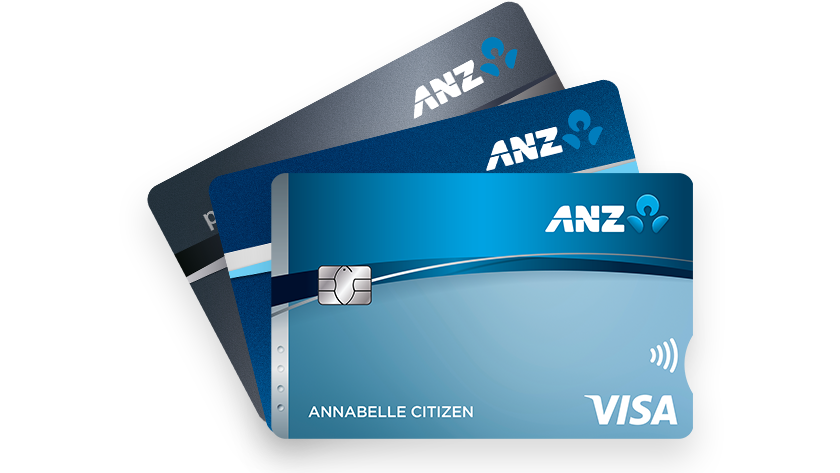Fraud protection.
Now it's personal.
ANZ Falcon® technology monitors millions of transactions every day to help keep you safe from fraud.
Falcon® is a registered trademark of Fair Issac Corporation.
As a credit cardholder, you’re only obligated to pay the Minimum Monthly Payment each statement period.
However, if you only make the minimum repayment, you’ll end up paying more interest and it could take you longer to pay off your credit card. Below we explain why.

When you get your credit card statement, you’ll see a Minimum Monthly Payment figure and a Due Date.
You must pay the Minimum Monthly Payment by the Due Date – plus any amounts due immediately, such as any overlimitdisclaimer or overdue amountsdisclaimer – otherwise you’ll be charged a late payment fee on top of any interest charged to your credit card account.
While it may be tempting to only pay the Minimum Monthly Payment each month, your goal should be to pay off as much of the Closing Balance (or if applicable, the 'Adjusted Closing Balance') as you can afford by the Due Date on your statement. That way, you could potentially pay less interest on your credit card while avoiding any late payment fees.
What’s more, if you’re disciplined and pay back your Closing Balance (or if applicable, the ‘Adjusted Closing Balance’) in full by the Due Date every month, you can avoid paying interest on your eligible card purchases altogether.
Here are some tips on how to stay on top of your credit card repayments.
We’re going to tell it to you straight. If you frequently use your credit card and only make the Minimum Monthly Payment, you might quickly find yourself in financial trouble.
There are two things to remember:
In the example below, this credit card has a Closing Balance of $6,288.52 with an interest rate of on purchases only.disclaimerdisclaimer
The Minimum Monthly Payment, which is $126.00 per month in this example, can be found at the top right corner of the statement.disclaimer
Now take a look at the Government warning at the bottom of the statement.
If you were to only pay the Minimum Monthly Payment of $126.00 each month, it would take you approximately 59 years and 10 months to clear your card debt of $6,288.52. What’s more, you’ll end up paying an estimated $34,836.11 in interest over that 59-year-plus period.disclaimer
And that’s assuming you make no new purchases or transactions, and your fees and interest rate don’t change. A sobering thought, but don’t despair yet.
The Government warning also gives you an estimate of how much you’ll need to pay back each month to clear your card debt of $6,288.52 within two years. In this case, it’s approximately $323.11 per month.
Do this and you’ll pay approximately $1,466.12 in interest over that two-year period – a saving of $33,369.99 (assuming you make no new purchases or transactions, and your fees and interest rate don’t change).disclaimer
As you can see, the difference between the two is considerable, which is why it’s advisable to always pay as much as you can.

Looking for some tips on how to manage your money a little better so that you can increase your credit card repayments? You may find our articles on spending habits and tips for a weekly budget useful. For comprehensive tips, tools and guides on budgeting and saving, check out ANZ Financial Wellbeing.
If you don’t pay the Closing Balance (or if applicable, the 'Adjusted Closing Balance') in full by the Due Date shown on your statement, we will charge you interest on the Purchases balance from the day after the Due Date.
Therefore, the best way to avoid paying credit card interest is to pay the Closing Balance (or if applicable, the 'Adjusted Closing Balance')disclaimer in full by the Due Date each month.
At ANZ, the interest-free period on purchases for our non-business cards varies depending on the credit card.disclaimer
Some cards – such as ANZ Low Rate, ANZ First and ANZ Platinum – come with up to 55 days' interest free. Whereas others – such as ANZ Rewards Black, ANZ Rewards Platinum, ANZ Frequent Flyer Black and ANZ Frequent Flyer Platinum – come with up to 44 days’ interest free.disclaimer
Remember, it’s “up to” 44 or 55 days, not 44 or 55 days from each purchase. Given interest-free periods run from the beginning of a statement cycle until the payment Due Date, the number of interest-free days will depend on when you make the purchase within your statement cycle (and the type of purchase).disclaimer
By sticking to this one golden rule – that is, paying off your credit card in full by the Due Date each month – you’ll avoiding paying interest on your credit card Purchases balance, while making positive moves towards your financial wellbeing.
Review your budget to see where you can make some cutbacks on your discretionary spending, or sell some things you no longer need, and then commit to using those savings to make higher repayments on your credit card. You can also use helpful tools such as the MoneySmart credit card calculator to illustrate how much of a difference extra repayments make.disclaimer
Other options that may be available to you include consolidating your card debt through a balance transferdisclaimer or a personal loan.
Transfer the balance of one or more credit cards or store cards onto an ANZ credit card with a Balance Transfer.disclaimer
If you’re experiencing financial difficulty, our Customer Connect team can assess your situation and look at options that may be available to you – whether that’s giving you a hand in the short term or setting you up for the long term. Learn more by visiting financial hardship.

A balance transfer might be a great way to consolidate your card debt at a lower interest rate to help you feel more in control.disclaimer
Let’s face it, paying credit card interest bites big time. Especially when it can be avoided. Below we’ll look at how to minimise your credit card interest – and how to avoid paying it altogether.
Thinking of applying for a new credit card? Make sure you consider a credit limit that aligns with your spending habits and your ability to repay your card balance.
A promotional Balance Transfer offer, if used wisely, may make it easier for you to consolidate your credit card debt and pay it off sooner.
The information is current as 7 February 2025 and may be subject to change. ANZ recommends you review your personal credit card contract for information about the terms that apply to you.
Advice is general and may not be right for you and does not take into account your individual circumstances, such as your objectives or financial situation or needs. By providing this information ANZ does not intend to provide any financial advice or other advice or recommendations. You should seek independent financial, legal, tax and other relevant advice having regard to your particular circumstances.
ANZ interest rates and fees and terms and conditions are subject to change. Refer to the current credit card interest rates, fees and terms for further information and current interest rates, fees and terms.
Applications for credit at ANZ are subject to ANZ's credit approval criteria, terms, conditions and fees and charges apply. Australian Credit License Number 234527.
An overlimit fee will be charged in these circumstances. You can ask ANZ to decline certain transactions so that you don't exceed your credit limit. Please refer to the ANZ Credit Cards Conditions of Use (PDF) for further information.
ReturnThe overlimit amount on a credit card refers to the amount by which a cardholder exceeds their credit limit. Eligibility criteria, fees & charges may apply.
ReturnCompared to if the account holder had paid their Closing Balance in full each month.
ReturnThe information provided in the Minimum Repayment Warning is provided as a guide only. It provides an estimate of how long it will take an account holder to pay off a credit card Closing Balance for a particular month if the account holder only pays the Minimum Monthly Payment each month. It shows how much interest the account holder could end up paying assuming the account holder makes no new transactions and fees and interest rates do not change.
ReturnExample provided is for ANZ Frequent Flyer Black credit card. Standard annual interest rate is on the purchases balance, on the cash advances balance and on the standard balance transfers balance as at today's date and is subject to change.
ReturnThe information in this example is for illustrative purposes only and may not reflect how interest and charges are calculated under your credit card contract. The example assumes an interest rate on purchases of . It also assumes that the customer has made no cash advances or entered into any ANZ Instalment Plans. It also assumes that the customer makes no new transactions and fees and interest rates on the card do not change.
ReturnIf you have both overdue amounts and overlimit amounts, then the greater of those amounts will be the ‘Payable Immediately’ amount. If we don’t include amounts that are immediately due in the ‘Payable Immediately’ amount then we may add them to the Minimum Monthly Payment instead.
ReturnAt ANZ, if a consumer Credit Card Account has interest-free periods on purchases, the account holder can avoid paying interest on the purchases balance by always paying the full Closing Balance (or if applicable, the ‘Adjusted Closing Balance’) shown on each statement by the applicable due date. Interest free periods on purchases do not apply if you do not pay the Closing Balance (or if applicable, your 'Adjusted Closing Balance') shown on each statement in full by the applicable due date. Your Adjusted Closing Balance is calculated as your Closing Balance less the sum of any relevant Promotional Plan balances that relate to an Instalment Plan, a Buy Now Pay Later plan, or a Promotional Balance Transfer Plan, plus any instalments due (including instalments previously due which have not yet been paid). Not all transactions (e.g., cash advances) get the benefit of interest-free days. Payments to your account are applied in the order set out in the ANZ Credit Cards Conditions of Use (PDF). Existing customers should review their credit contract for information regarding their account.
ReturnFor more information on interest free days, please refer to the ANZ Credit Card Conditions Of Use (PDF).
ReturnNot all transactions (e.g., at ANZ cash advances) get the benefit of interest-free days. Refer to the applicable credit contract for details of which (if any) transactions are eligible for interest-free days.
ReturnThe Money Smart credit card calculator is a tool provided on the website as at 8 May 2019. As at 8 May 2019 that website indicates that the tool is a model, not a prediction and that results from the tool are only estimates. ANZ recommends that you read the disclaimer and assumption information provided on that website (or for any other estimation tool) before using that tool. ANZ has not verified the accuracy of the tool and makes no representations as to its accuracy.
ReturnApplies to transfers of $100 or more from eligible non-ANZ Australian credit and store card debts only. ANZ cannot accept a transfer if the balance of your card has reached 95% or more of the available credit limit balance, if you are in default on any existing ANZ credit card account or if the other account named in your application is in default at the time the application is received.
Return